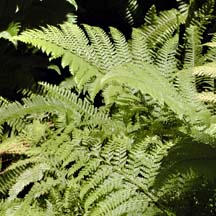
In the Garden![]()
Rick Barboza
Palapalai
LATIN NAME
Microlepia strigosa
Description: Medium-sized ferns that grow to be about 2- to 3-plus feet tall.
Fronds are very soft and are usually light- to medium-green in color. Individual blades and midrib are usually very hairy as described by its Latin species name, striga, which means short, bristle-like hairs.
The degree of hairiness ranges from light to very heavy and are acknowledged as separate varieties.
HUI KU MAOLI OLA
Palapalai is available for a limited time at the Iwilei Home Depot native plant section. The palapalai being sold comes from Oahu.
Distribution: Palapalai is an indigenous fern, meaning that it is native to Hawaii and other places.
It is found here on all the main islands, usually in mesic forests but occasionally in dry or even wet forests from near sea level to about 5,000 feet.
Cultural uses: Palapalai is an important plant in Hawaiian culture, primarily for hula.
It is one of the plants sacred to Laka, the goddess of hula, and used to adorn the hula altar and dancer, and is highly sought for making lei. Many songs and chants refer to palapalai for its beauty and cultural importance.
Landscape uses: For years palapalai has been sold in stores and used in landscapes here in Hawaii and throughout the world, although chances are these are not the ones native to Hawaii; they are more likely to come from Asia where they are also native. Even ferns usually sold here as "palapalai" are propagated either on the mainland or sometimes Mexico, before being shipped to Hawaii nurseries. Hawaiian varieties have been grown only in recent years, thanks to fern lady Kay Lynch who propagates them from spores.
Once you get the Hawaiian variety, you can plant them in any semi-shaded area such as under the eve of your house, at the base of a tree, or even in a bright room with daily misting. Daily watering is OK once it is planted in the ground.
Routine application of compost, mulch or fertilizer will keep your plant looking full and green.
Keep palapalai in a protected area since they can be prone to wind damage.
Details: This fern is also known as palai, and there are many other ferns, both native and non-native, that have "palai" in part of their name. "Palapalai" is also the name of another Ni'ihau native fern more commonly known as 'okupukupu (Nephrolepis exaltata).
Gardening Calendar


